Intel SSD 730 (480GB) Review: Bringing Enterprise to the Consumers
by Kristian Vättö on February 27, 2014 12:00 PM EST- Posted in
- Storage
- SSDs
- Intel
- Intel SSD 730
Random Read/Write Speed
The four corners of SSD performance are as follows: random read, random write, sequential read and sequential write speed. Random accesses are generally small in size, while sequential accesses tend to be larger and thus we have the four Iometer tests we use in all of our reviews.
Our first test writes 4KB in a completely random pattern over an 8GB space of the drive to simulate the sort of random access that you'd see on an OS drive (even this is more stressful than a normal desktop user would see). I perform three concurrent IOs and run the test for 3 minutes. The results reported are in average MB/s over the entire time. We use both standard pseudo randomly generated data for each write as well as fully random data to show you both the maximum and minimum performance offered by SandForce based drives in these tests. The average performance of SF drives will likely be somewhere in between the two values for each drive you see in the graphs. For an understanding of why this matters, read our original SandForce article.

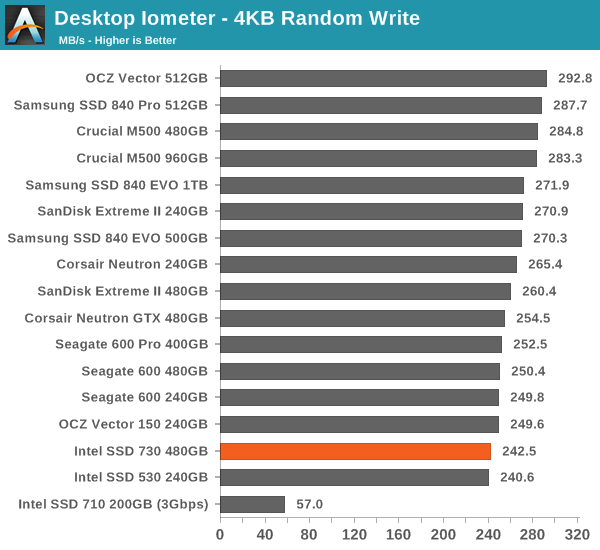
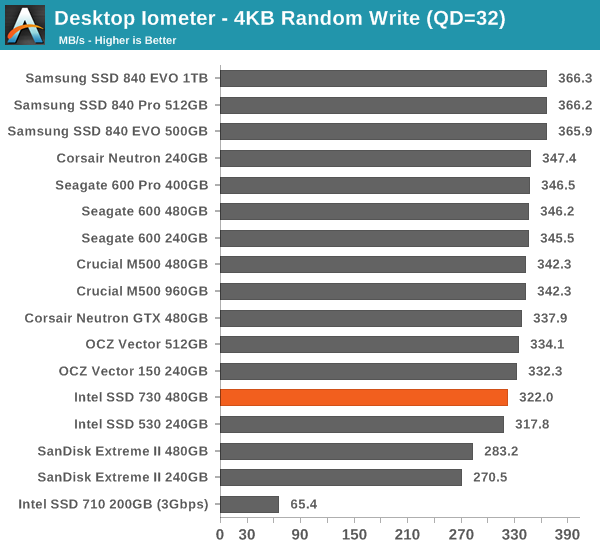
The SSD 730 isn't the fastest in peak performance because that's irrelevant in the enterprise space. We are still looking at decent random write performance and the random read performance is actually surprisingly good.
Sequential Read/Write Speed
To measure sequential performance I ran a 1 minute long 128KB sequential test over the entire span of the drive at a queue depth of 1. The results reported are in average MB/s over the entire test length.
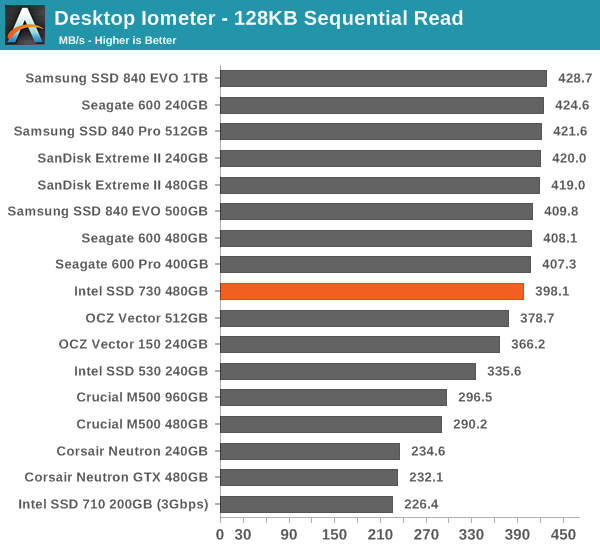
The same goes for sequential performance: the 730 is an average performer with focus on consistency.
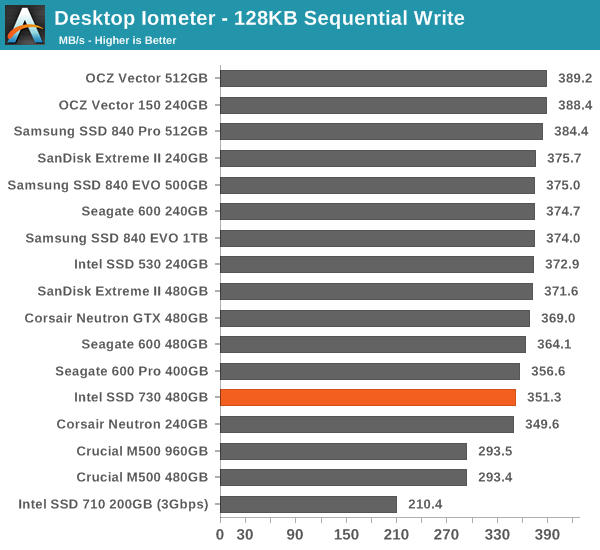
AS-SSD Incompressible Sequential Read/Write Performance
The AS-SSD sequential benchmark uses incompressible data for all of its transfers. The result is a pretty big reduction in sequential write speed on SandForce based controllers.
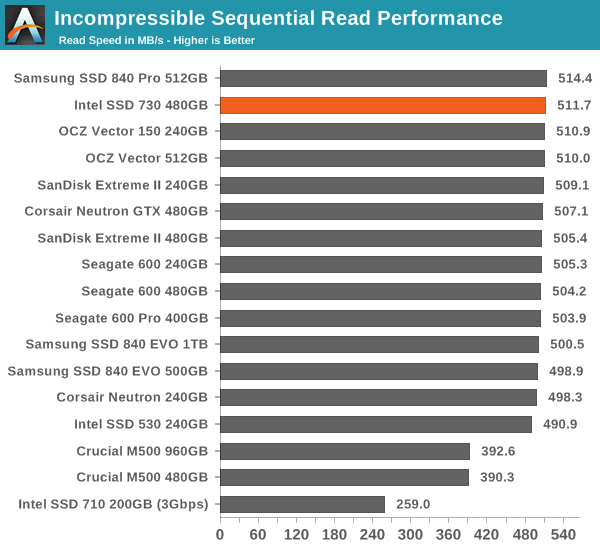
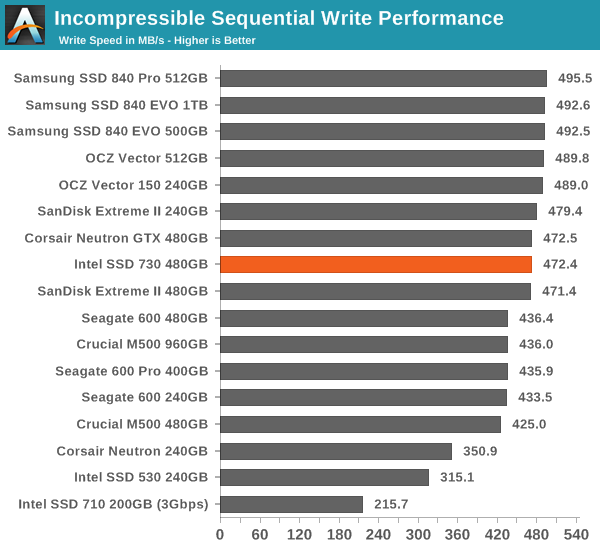










96 Comments
View All Comments
CrazyElf - Thursday, February 27, 2014 - link
Seeing that the SSD market is a low margin market, I get the feeling that Intel's strategy is to use it's existing reputation as a "reliable" vendor of SSD solutions and milk it so to speak. So that means little competition from a serious price to performance stand point, and more focus on product margins.NCM - Thursday, February 27, 2014 - link
I've reread the first page about 5 times and I still can't tell what controller is in this drive. There's reference to previous use of SF, but no indication of what's now in use.Did that info end up on the editing room floor?
Death666Angel - Thursday, February 27, 2014 - link
From the text "Adopting the platform from the DC S3500/S3700", "The controller is the same 8-channel design as in the S3500/S3700 but runs at 600MHz instead of the 400MHz of the S3500/S3700.". From the table "Controller Intel 3rd Generation (SATA 6Gbps)".NCM - Friday, February 28, 2014 - link
@Death666Angel (!) Thanks for the controller parsing. A rather convoluted way for readers to arrive at an answer, but we get there in the end.In a related matter the reviewer writes: "We use both standard pseudo randomly generated data for each write as well as fully random data to show you both the maximum and minimum performance offered by SandForce based drives in these tests. The average performance of SF drives will likely be somewhere in between the two values for each drive you see in the graphs."
However in none of the tables are the Sandforce drives identified. Apparently we're supposed to have memorized beforehand what controllers each drive uses. This is not some a mere quibble on my part. We have a couple of dozen workstations using SSD's, and because we work with a lot of incompressible data I do not buy drives with SF controllers.
Please AnandTech: if you're going to bother making technical distinctions of this kind, make it clear where they apply.
Mr Perfect - Friday, February 28, 2014 - link
That's strange, they used to label the drives in the charts with what controller was in them.Kristian Vättö - Saturday, March 1, 2014 - link
The controller is also listed in the table, although it's just "Intel 3rd gen" as to my knowledge it doesn't have any specific codename.As for the other feedback, the part you quoted it just a boilerplate that was we use in every review but I see that there's a need to update it.
Mipmap - Thursday, February 27, 2014 - link
"to invest in custom client-orientated silicon." oriented"There wasn't much competition and given Intel's resourced" resources
Death666Angel - Thursday, February 27, 2014 - link
Orientated/oriented is a preference thing. Neither option is wrong.CalaverasGrande - Thursday, February 27, 2014 - link
the meaning is conveyed either way, but I have always taken orientated in the same way I take "moneys'. While I understand the intent, it still sounds awkward and uneducated.redmist77 - Thursday, February 27, 2014 - link
Saying 'orientated' is as dumb as saying 'documentated' or 'adaptated.'